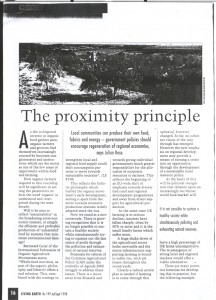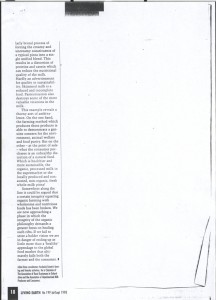March 2000, updated May 2001
Objective
Designate a “rural development hub” in the County which would act as a model for integrated sustainable development at the local level and catalyst for rural development.
Set in motion solutions for a number of key concerns as outlined in the 1999 Oxfordshire Farming Study.
Justifications
The concept of “sustainable development” has been adopted by many agencies with an interest in the future of the countryside, enterprise and conservation, notably SEEDA (the South East of England Development Agency). Yet it lacks tangible examples and often confuses rather than clarifies.
Preamble to Project
It has been said “Oxfordshire Pivots around Market Towns.”
This important observation holds a clue for a successful remedy to the present rural crisis.
Historically, the County Market Town was the axis around which trade in agricultural and artisan products turned. Its architectural design sets the market place at the centre, and has access roads radiating out into the surrounding countryside, designed to facilitate the easy movement of people and goods.
The dynamic activities of the market place have declined steadily throughout the 20th Century as the boundaries of trade have moved into the global arena, and the local resource base has lost its significance. In the last decade or two there has been little more than token market place trading in these once bustling centres. They have in effect “died” – unless you consider that insurance companies, travel and estate agents plus the odd tea room constitute a thriving town centre! Most people living in the typical market town no longer work locally, nor shop locally, nor have any connection with the resource base of their region.
All this could change, however, and it is my belief that now is the time to embrace the potential for the rejuvenation of the market town and rural hinterland. Focussing on the creation of such a hub would:
- Counteract the debilitating effects of the current crisis in agriculture and its attendant knock-on effects on the rural economy
- Develop a rural model that can demonstrate sustainable development through a multidisciplinary approach covering social, economic and environmental criteria.
- Draw on government’s current sustainable indicator targets (including quality of life). These include significantly cutting back car and truck miles, CO2 emissions and commercial/household waste.
The project framework
“In the past, focus has centred mainly on improving labour productivity. In the future, greater emphasis will be needed on resource efficiency. We need to break the link between continued economic growth and increasing use of resources and environmental impacts” (Rt Hon John Prescott MP, Deputy Prime Minister and Secretary of State for the Environment, Transport and the Regions).
The project will centre on an existing market town (current preference, Faringdon), and will seek input from local farmers, business people, and those active in education and the arts, in addition to the relevant local authorities. It is envisaged as a five year plan.
1. FOOD FARMING
Develop a local (under supplied) market as opposed to global (oversupplied) market through forging closer links between locally productive farm land and the town’s requirement for primary, seasonal agricultural produce via markets, distribution outlets, existing shops, restaurants and public authority/school canteens.
2. ENERGY
Develop a ‘renewable energy’ contract with local woodland, biomass and alternative crop production enterprises to supply an increasing percentage of the energy requirements from the local sustainable resource base. Solar and wind energy may also be incorporated.
3. FABRIC and FIBRE
Explore and exploit the potential for local renewable building/construction materials to be utilized in meeting demand of light industrial and other appropriate constructions.
4. SOCIAL
Determine key quality of life indicators for local population. Develop ‘village appraisal’ models, affordable housing agenda, local job opportunities and rural transport networks.
5. ARTS
Explore potential for revival of creative arts which can both complement and catalyse the overall project. Draw local youth into creative programmes.
6. EDUCATION
Tap into local education authority (and private sector) as key participants/partners of the evolving project. School could play a central role in assessing targets for local food and energy requirements of the market town.
7. ECONOMICS
The underlying economic theme within the project is to view the market town as an ‘innovation hub’ able to build on the potential of small and medium-sized businesses, to engage in new partnerships and innovative marketing concepts within the overall pattern of local sustainability objectives.
8. TECHNOLOGY
Develop the technology for telecottage and advanced communications through embracing ‘the wired region’ initiative favoured by SEEDA. Apply this to an advanced marketing strategy for the enhancement of local/regional trading.
Julian Rose
March 2000, updated May 2001




